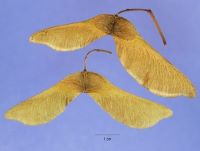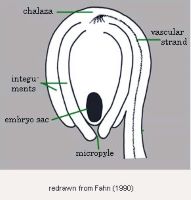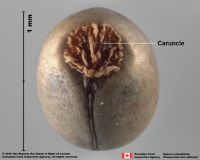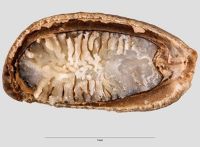Content is from Kirkbride et al. 2006Kirkbride et al. 2006:
Kirkbride JH, Jr, Gunn CR, and Dallwitz MJ. 2006. Family guide for fruits and seeds, vers. 1.0. Accessed September 2020-January 2022. URL: https://nt.ars-grin.gov/seedsfruits/keys/frsdfam/index.cfm ., without modification.
Updates are forthcoming.
Fruits: Pistil(s) compound; 1; 1-pistillate; with carpels united. Fruit pericarpium; simple, or schizocarpschizocarp:
usually dry fruit splitting between two or more locules to form distinct, indehiscent, usually one seeded segments; fruit derived from a single, superior or inferior, compound ovary; compare to mericarp ; drupedrupe:
; drupedrupe:
(indehiscent drupe) a fleshy, indehiscent fruit with one more hard pits enclosing seeds, derived from single, superior, simple or compound ovary; (dehiscent drupe) a fruit with a dry or fibrous to fleshy or leathery outer husk that early to tardily breaks apart (or opens), exposing one or more nutlike pits enclosing the seeds , or capsulecapsule:
, or capsulecapsule:
a dry, dehiscent fruit derived from a compound ovary , or samarasamara:
, or samarasamara:
a winged, indehiscent, dry fruit containing a single (rarely two) seed(s) (Zinowiewia), or berryberry:
(Zinowiewia), or berryberry:
an indehiscent, fleshy fruit with one or a few to many seeds. The flesh may be homogenous throughout. Or, if the outer part is hard, firm, or leathery, referred to as an hesperidium. Septa are present in some, and the seeds may be arillate or with a fleshy testa. ; follicarium (Reissontia); loculicidalloculicidal:
; follicarium (Reissontia); loculicidalloculicidal:
type of capsular dehiscence, opening longitudinally through the locules (compare septicidal)
 capsulecapsule:
capsulecapsule:
a dry, dehiscent fruit derived from a compound ovary (Maytenus), or septifragalseptifragal:
(Maytenus), or septifragalseptifragal:
type of capsular dehiscence, splitting through the exterior wall suture(s) but not the septum(-a), the valves of the wall then separating from the septum(-a) and the locules thus opened directly to the outside
capsulecapsule:
a dry, dehiscent fruit derived from a compound ovary (Glyptopetalum); capsulecapsule:
(Glyptopetalum); capsulecapsule:
a dry, dehiscent fruit derived from a compound ovary not inflated; capsulecapsule:
not inflated; capsulecapsule:
a dry, dehiscent fruit derived from a compound ovary without operculumoperculum:
without operculumoperculum:
a dehiscent cap (or lid) of a seed or fruit that opens during germination or dehiscence ; berryberry:
; berryberry:
an indehiscent, fleshy fruit with one or a few to many seeds. The flesh may be homogenous throughout. Or, if the outer part is hard, firm, or leathery, referred to as an hesperidium. Septa are present in some, and the seeds may be arillate or with a fleshy testa. indehiscent; berryberry:
indehiscent; berryberry:
an indehiscent, fleshy fruit with one or a few to many seeds. The flesh may be homogenous throughout. Or, if the outer part is hard, firm, or leathery, referred to as an hesperidium. Septa are present in some, and the seeds may be arillate or with a fleshy testa. without central placental mass; without persistent central column; not within accessory organ(s); more than 1 but less than 10-seeded, or many-seeded; 2–100-seeded; from 1–5 cm long; 2.2–2.3 cm long; with 3-carpellate (2–5); with carpels united; with carpels remaining united at maturity; without sterilesterile:
without central placental mass; without persistent central column; not within accessory organ(s); more than 1 but less than 10-seeded, or many-seeded; 2–100-seeded; from 1–5 cm long; 2.2–2.3 cm long; with 3-carpellate (2–5); with carpels united; with carpels remaining united at maturity; without sterilesterile:
lacking male and/or female reproductive parts; also, not producing fruit or seed
 carpels; apexapex:
carpels; apexapex:
the point farthest from the point of attachment, or the "tip" of an organ not beaked; dehiscentdehiscent:
not beaked; dehiscentdehiscent:
(v. dehisce) splitting open at maturity to release contents (of a fruit) , or indehiscentindehiscent:
, or indehiscentindehiscent:
not opening on its own, as in a fruit
 . Dehiscentdehiscent:
. Dehiscentdehiscent:
(v. dehisce) splitting open at maturity to release contents (of a fruit) unit seed(s). Dehiscentdehiscent:
unit seed(s). Dehiscentdehiscent:
(v. dehisce) splitting open at maturity to release contents (of a fruit) regularly; actively; without replumreplum:
regularly; actively; without replumreplum:
the rim, formed by the persistent placentas, and connected by a false septum in Brassicaceae fruits. The fruit valves are attached to this rim and separate from it in dehiscent fruits.
. Epicarpepicarp:
outer layer of fruit wall or pericarp, if divided into layers; note here used synonymously with exocarp red, or pink, or yellow; durable; glabrousglabrous:
red, or pink, or yellow; durable; glabrousglabrous:
without hairs
; without armature; without wing(s), or with wing(s); 5-winged; with wing(s) laterallateral:
(of embryo) embryo lies along the side of the seed, generally towards one end; of, at, or from the side; in grasses, can refer to the sides adjacent to the dorsal and ventral sides
; without apicalapical:
at or pertaining to the end of the seed or fruit distal from its point of attachment (i.e., base)
respiratory hole. Mesocarpmesocarp:
the middle layer of the pericarp, if divided into layers present, or absent. Endocarpendocarp:
present, or absent. Endocarpendocarp:
the inner layer of the pericarp, if divided into layers present, or absent; not separating from exocarpexocarp:
present, or absent; not separating from exocarpexocarp:
outer layer of fruit wall or pericarp, if divided into layers; note here used synonymously with epicarp ; thin, or bonybony:
; thin, or bonybony:
very hard and rather brittle, like bone
; splitting into 1-seeded pyrenespyrene:
the hard inner portion of a drupe, consisting of a bony endocarp and an enclosed seed
, or not splitting into 1-seeded pyrenes; stone unilocular, or plurilocular; stone 1–3-loculate; without wing; without operculumoperculum:
a dehiscent cap (or lid) of a seed or fruit that opens during germination or dehiscence ; without secretory cavities; without grooves; without longitudinallongitudinal:
; without secretory cavities; without grooves; without longitudinallongitudinal:
of or relating to length or the lengthwise dimension
ridges. Funiculusfuniculus:
(alt. funicle) stalk connecting the ovule (later seed) to the ovary (later fruit) placenta short, or long; short without seed bearing hookswith hooks:
short, or long; short without seed bearing hookswith hooks:
bristles or spines with curved or backwards pointing tips, or with secondary bristles along their length (retinacula); not persisting in fruit after seed shed.
(retinacula); not persisting in fruit after seed shed.
Seeds: Arilaril:
(broad sense) appendicular structure that wholly or partly envelops a seed and is produced from or a modification of the funicle, raphe, or outer integument; usually fleshy or pulpy, sometimes spongy or tufted-capillate, often brightly colored present, or absent (on winged seeds); a true arilaril:
present, or absent (on winged seeds); a true arilaril:
(broad sense) appendicular structure that wholly or partly envelops a seed and is produced from or a modification of the funicle, raphe, or outer integument; usually fleshy or pulpy, sometimes spongy or tufted-capillate, often brightly colored , or an arillike structure; including scarlet red, or orange, or yellow, or white; adnate to testatesta:
, or an arillike structure; including scarlet red, or orange, or yellow, or white; adnate to testatesta:
seed coat
 ; fleshy; of funicularfuniculus:
; fleshy; of funicularfuniculus:
(alt. funicle) stalk connecting the ovule (later seed) to the ovary (later fruit) placenta origin, or micropylarmicropyle:
origin, or micropylarmicropyle:
an opening in the integuments of an ovule usually acting as a passage for the pollen tube origin, or outer integumentintegument:
origin, or outer integumentintegument:
ring-like or hood-like structure(s) that envelopes the nucellus, at maturity is the layers of the seed coat origin; encompassing; fleshy; fimbriate-laciniate, or cupshaped; lobed. Arillike structure falling with seed a carunclecaruncle:
origin; encompassing; fleshy; fimbriate-laciniate, or cupshaped; lobed. Arillike structure falling with seed a carunclecaruncle:
a localized outgrowth of the seed coat near the hilum of the seed; it functions as an elaiosome (Corner: arilloid). Seed larger than minute; 1 to less than 5 mm long to 25 to less than 50 mm long; 2–20 mm long; angularangular:
(Corner: arilloid). Seed larger than minute; 1 to less than 5 mm long to 25 to less than 50 mm long; 2–20 mm long; angularangular:
2D shape—having sides that meet at acute or obtuse angles
, or oblongoblong:
2D shape—much longer than broad with nearly parallel sides, corners are rounded ; in transection compressedcompressed:
; in transection compressedcompressed:
flattened; in grasses, used to denote compression (not necessarily flattened) either laterally or dorsiventrally
, or flattened; not bowl shaped; not nutlike; without winglike beakbeak:
a usually firm, terminal appendage, sometimes tapered ; without caudatecaudate:
; without caudatecaudate:
tapering to a long, tail-like appendage appendage(s); at maturity with food reserves; with endosperm (seldom none), or perispermperisperm:
appendage(s); at maturity with food reserves; with endosperm (seldom none), or perispermperisperm:
seed nutritive tissue comparable to the endosperm, but derived from the nucellus (maternal tissue)
(rarely); without canavanine. Sarcotestasarcotesta:
pulpy or fleshy outer layer of the seed coat, simulates aril absent, or present (Microtropis); fleshy. Testatesta:
absent, or present (Microtropis); fleshy. Testatesta:
seed coat
 present; with fleshy or leatheryleathery:
present; with fleshy or leatheryleathery:
texture—moderately thick, tough, and very pliable
layer over hard layer; shinyshiny:
uniformly reflecting a high proportion of incident light at all angles ; surface smooth, or unsmooth; surface with discreet raised features, or merged raised features; surface papillatepapillate:
; surface smooth, or unsmooth; surface with discreet raised features, or merged raised features; surface papillatepapillate:
surface relief—bearing minute, distinct, broad-based projections, tapering to a rounded apex ; surface rugoserugose:
; surface rugoserugose:
wrinkled , or striatestriate:
, or striatestriate:
surface relief—having fine, parallel lines, grooves or ridges ; without crease or line separating cotyledons from hypocotyl-radicle; without notch along margin where cotyledons from hypocotyl-radicle tip approach each other; without glands; without bristles; glabrousglabrous:
; without crease or line separating cotyledons from hypocotyl-radicle; without notch along margin where cotyledons from hypocotyl-radicle tip approach each other; without glands; without bristles; glabrousglabrous:
without hairs
; without wings, or with wing(s) (winged esp. Hippocratus); without collar; without operculumoperculum:
a dehiscent cap (or lid) of a seed or fruit that opens during germination or dehiscence ; colored; monochrome; blue, or orange, or yellow, or white, or red, or black, or brown (all shades); crustaceouscrustaceous:
; colored; monochrome; blue, or orange, or yellow, or white, or red, or black, or brown (all shades); crustaceouscrustaceous:
texture—thin, dry, indurate, and brittle
, or membranousmembranous:
texture—extremely thin, pliable, and fairly tough
; not becoming mucilaginousmucilaginous:
resembling mucilage; moist and sticky
when wetted; surrounding embryo, or surrounding food reserve. Rapheraphe:
a ridge or seam on the seed coat, formed by the portion of the funiculus united to the ovule wall in longitudinally curved ovules conspicuous (often longitudinally), or inconspicuous. Endosperm development nuclear; copious; fleshy, or hard (bonybony:
conspicuous (often longitudinally), or inconspicuous. Endosperm development nuclear; copious; fleshy, or hard (bonybony:
very hard and rather brittle, like bone
or horny), or fleshy-watery; smooth; with oils; without fatty acid containing cyclopropene; without apicalapical:
at or pertaining to the end of the seed or fruit distal from its point of attachment (i.e., base)
lobes; without chlorophyll; without isodiametric faceted surface; without odor. Perispermperisperm:
seed nutritive tissue comparable to the endosperm, but derived from the nucellus (maternal tissue)
opaqueopaque:
not transmitting light
. Embryo differentiated from food reserve; well developed; 1 per seed; partially filling testatesta:
seed coat
 (with food reserve); at one end of seed not extending into a depression or cup; axileaxile:
(with food reserve); at one end of seed not extending into a depression or cup; axileaxile:
on or of the axis
and centric; foliatefoliate:
appearing leaf-like
; with investinginvesting:
(of embryo) embryo is nearly or completely filling seed coat, straight, and axile and centric with spatulate cotyledons and covering the stalk for at least half its length; (of cotyledons) cotyledons spatulate and covering the stalk for at least half its length
cotyledons, or spatulatespatulate:
2D shape—like a spatula; rounded at the apex, with base long and tapered; (of embryo) embryo is straight and axile and centric with the cotyledons expanded to form the shape of a spatula or spoon; (of cotyledons) cotyledons expanded and wider than the stalk but not invested into the stalk cotyledons; straight, or C-shapedC-shaped:
cotyledons; straight, or C-shapedC-shaped:
2D-shape—semiannulate, curved into the shape of the letter 'C'
; parallel to seed length, or obliqueoblique:
in a slanting direction or position, neither horizontal nor vertical
to seed length; with cotyledons abruptly connected to hypocotyl-radicle; without coleorhiza; without simmondsin; without stomata; often green; with 2 or more cotyledons. Cotyledons 2; well developed; Perrottia 0.1–0.9 times length of embryo; somewhat to significantly wider than hypocotyl-radicle; 1.7–10 times wider than hypocotyl-radicle; not concealing hypocotyl-radicle, or partially concealing hypocotyl-radicle; moderately thick, or thin; flat; smooth, or ruminateruminate:
testa or seed coat folded into the endosperm ; with apicesapex:
; with apicesapex:
the point farthest from the point of attachment, or the "tip" of an organ entire; with margins connate, or separate; basally entire, or cordatecordate:
entire; with margins connate, or separate; basally entire, or cordatecordate:
2D shape—heart-shaped, with attachment at or near the broad end (compare obcordate) (somewhat cordatecordate:
(somewhat cordatecordate:
2D shape—heart-shaped, with attachment at or near the broad end (compare obcordate) ); equal in size; not punctatepunctate:
); equal in size; not punctatepunctate:
surface relief—dotted with pits or with translucent, sunken glands or with colored dots, similar to pitted dotted. Hypocotyl-radicle moderately developed, or small; straight, or curvedcurved:
dotted. Hypocotyl-radicle moderately developed, or small; straight, or curvedcurved:
(of embryo) linear embryo is curved into an arch or horseshoe with the ends far apart (slightly); not thickened.
(slightly); not thickened.
Noxious weeds: 1 or more USA state noxious weeds in this family.
USA states and territories with listed noxious weeds: North Carolina (NC) and Vermont (VT).
USA state and territory noxious weeds:
Celastrus orbiculatus Thunb.: USA state noxious weed: NC●, VT●.
Symbols: ªaquatic weed; ●terrestrial weed; °weed in seed.
Last updated February 2006.
Literature specific to this family: Hallé, N. 1962. Monographie des Hippocratéacées d'Afrique Occidentale. Mém. Inst. Franç. Afrique Noire No. 64; Hallé, N. 1983. Révision des Hippocrateae (Celastraceae): 3. Fruits, graines et structures placentaires. Bull. Mus. Natl. Hist. Nat., B, Adansonia 5:11–25.
General references: Baillon, H.E. 1866–95. Histoire des plantes, 13 vols. Hachette & Co., Paris, Corner, E.J.H. 1976. The seeds of Dicots, esp. vol. 2. Cambridge University Press, New York, Cronquist, A. 1981. An integrated system of classification of flowering plants, 1,262 p. Columbia University Press, New York, Gaertner, J. 1788–1805. De fructibus et seminibus plantarum. The Author, Stuttgart, Goldberg, A. 1986 (dicots) & 1989 (monocots). Classification, evolution, and phylogeny of the familes of Dicotyledons. Smithsonian Contr. Bot. 58 for dicots (314 pp.) & 71 for monocots (74 pp.). [Goldberg's illustrations are reproduced from older publications and these should be consulted], Gunn, C.R., J.H. Wiersema, C.A. Ritchie, & J.H. Kirkbride, Jr. 1992 & amendments. Families and genera of Spermatophytes recognized by the Agricultural Research Service. Techn. Bull. U.S.D.A. 1796:1–500, LeMaout, E. & J. Decaisne. 1876. A general system of botany, 1,065 p. Longmans, Green, & Co., London, Mabberley, D.J. 1987. The plant-book, 706 p. Cambridge University Press, Cambridge, Martin, A.C. 1946. The comparative internal morphology of seeds. Amer. Midl. Naturalist 36:513–660, Roosmalen, M.G.M. van. 1985. Fruits of the Guianan flora, 483 pp. Institute of Systematic Botany, Wageningen Agricultural University. Drukkerij Veenman B.V., Wageningen, Schopmeyer, C.S. 1974. Seeds of Woodywoody:
texture—consisting mainly of indurate lignified tissues, characteristic of or resembling wood
plants in the United States. Agric. Handb. 450:1–883, and Spjut, R.W. 1994. A systematic treatment of fruit types. Mem. New York Bot. Gard. 70:1–182.